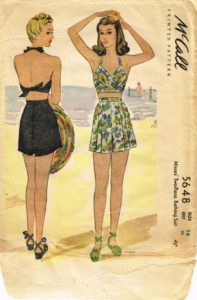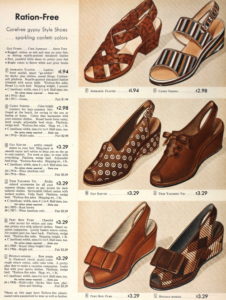Although millions of American women put on trousers and went to work when their workday was done they changed clothes and went about their day.
Nazi occupation and regulation dramatically affected American fashion during WWII (and beyond). On June 14, 1940, Hitler invaded and occupied Paris, the center of fashion at this time. Important Houses of Fashion, like Chanel, either closed their doors or fled the city. Those that did stay open were cut off from the rest of the world. This was the first time that a country other than France would be the leader in fashion.
While U.S. designers stepped up to fill this vacancy they had the additional challenge of creating clothing during wartime restrictions. Stanley Marcus of Neiman-Marcus department stores headed the textile division of the WPB (War Production Board). He forbade drastic style changes that might tempt buyers and created rules for the U.S. garment industry that were designed to reduce the textile used in women apparel by 15% and enforced stiff penalties to garment manufactures who didn’t abide by this order. The reduction included the elimination of double-breasted suits, no hoods or double cuffs on blouses, only one pocket on coats, no cuffs on trousers, only two buttons on sleeve cuffs, no pleats, ruffles, or waistbands over 3” wide, and many more. Other war restrictions banned metal zippers, elastic that was used in women’s foundation garments, and limited civilian footwear to three pairs a year to reserve leather and rubber for military needs.
To meet these challenges American found creative ways to create stylish clothing and accessories. Magazines helped women “make due” by publishing patterns or clothing designs. Old clothes were reshaped and sewn into new ones, and men’s suits were altered into women’s suits.
One of the more scandalous fashion changes that worked to reduce fabric usage was the 2-piece bathing suit. Although it was introduced in the 1930s the need to reduce fabric was definitely achieved by removing the mid-section of women’s swimsuits and photographs of Hollywood starlets in this attire promoted this style.

Two American designers that created signature styles despite the WPB restrictions were Claire McCardell and Norman Norell. McCardell, known in the fashion industry as the creator of American sportswear, she used denim, seersucker, and jersey to create classic dresses and separates. Although other designed bemoaned the restrictions on zippers McCardell embraced the challenge and in 1942, in response to a Harpers Bazaar challenge to create something fashionable to wear to clean the house and then wear to a party.
McCardell introduced her “Popover Dress” that could be worn as a house dress, dressing gown, swimsuit cover up, or a party dress. Selling for only $6.95 more than 75,000 were purchased the first season.
McCardell also commissioned dance shoe maker Capezio to create a line of ballet flat with a hard rubber sole to match her creations and a line of separates that made nine outfits from five pieces. In 1950 McCardell won the Women’s National Press Club’s Women of the Year award which was presented to her by President Truman, Bess Truman and Margaret Truman.
Another designer who’s designs emerged during WWII Norman Norell. Called one of the greatest designers of the twentieth century by Museum at FIT in New York City, Norell began his fashion career designing costumes in Hollywood but went on to own his own fashion house on 7th Avenue in New York City. In 1942 Norvell introduced his chemise dress that used unrationed sequins to add sparkle to his sheath dress. He introduced leopard prints in the 1940s and was the first American designed to have his own dress label.
Accessories, which helped brighten up a reworked of drab outfit were also under the scrutiny of the WPB. The WPB restricted shoe manufacturers to producing shoes in only 4 colors (black, white, town brown and military russet) and without extra trim or stitching. They also developed non-rationed shoes. Although the fashion had previously been high heels the new style to t-straps and lower heels used less leather. Shoes made of non-rationed materials including women’s wedge shoes which were made with a wedged heel of cork and a top made of organic materials also allowed civilians to work within the wartime restrictions.
Hats were one item that was not rationed and many magazines promoted a gaily decorated hat as a way to liven up an outfit and your attitude. While straw and felt supplies shrank due to lack of imported goods, American milliners discovered that materials normally used just to trim hats were plentiful. Ribbon, netting, horsehair, feathers, millinery flowers, all usually used only to decorate hats, were worked into total millinery extravaganzas. Hats made entirely of flowers or poufs of netting abounded. The turban also became a fashionable alternative to a hat that was also practical when women didn’t have the time access to hair beauty products or time for complicated hair styles.
As they say “necessity is the mother of invention” and as access to European fashion trends and materials for clothing and accessories were diverted to make armaments and other war material Americans learned to make do, while American designers created beautiful and innovative ways to make women fashionable during the war for freedom and democracy.
